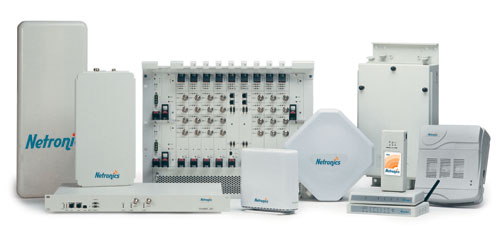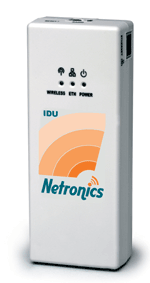|
The NetMAX Family

Key Facts
- NetMAX is the only
WiMAX based equipment that has been available since June 2004.
- The equipment is software upgradeable to the final
WiMAX standard when it becomes available. No change in the hardware will be needed.
- NetMAX CPE is powered by Intel's PRO/Wireless 5116 broadband interface, so future interoperability with other
WiMAX CPEs from any other vendor is guaranteed.
The CPE got Certified by WiMAX forum in July 2006
- Well established installation base with more than 130 networks in
100 countries working since June 2004 ensures the smooth operation in your network.
Schematic
Diagram

Architecture
NetMAX can be configured with two types of Base Stations:
- Hi Density Chassis, Macro Base Station
It is a carrier class 8U high cPCI shelf that fits into standard 19” or 22” (ETSI) racks. The chassis contains a Network Processor Unit (NPU) and up to 6 Access Units (AU) modules. The shelf is capable of accepting one more redundant NPU as well as a redundant AU module. The AU modules consist of an indoor unit (IDU) and an outdoor unit (ODU).

-
Micro Base Station
Micro Base Station is cost effective solution designed for low density rural areas.
The Micro Base Station IDU connects to the same outdoor radio unit as the Macro Base Station.

- Customer Premises Equipment (CPE)
The standard NetMAX CPE has an indoor/outdoor configuration with several types of indoor unit s and outdoor units. The IDU connects to ODU directly via a category 5 Ethernet cable that carries power, control signal between the IDU and ODU and data traffic.

The IDU types are:
-
CPE with one 10/100BaseT data port,
-
CPE with one10/100BaseT data port and one RJ11 POTS port,
-
CPE with one 10/100BaseT data port and two RJ11 POTS port,
-
CPE with four 10/100BaseT data ports and one 802.11 b/g wireless interface.

The ODU types are:
- NetMAX Indoor Self-Install CPE
All-in-One - Just open the box and plug it in…
The NetMAX SI is a compact, portable, indoor single box device. It will be placed near user's PC. It is designed for plug and play operation, enabled either via a SIM card or by using a user-friendly application provided on a CD with the unit.
The NetMAX self-install CPE supports intelligent antenna steering functionality using six antenna elements with 9dBi gain.

Services and interfaces supported include:
-
10/100 Base-T for IP data,
-
802.11b/g for WiFi hotspots,
-
1 or
2 POTS (RJ11) ports for voice services and
-
Battery back up.
Key Advantages
For customers:
-
Lower
cost of CPEs,
-
Plug and play SI make it easy to use,
-
More
broadband options,
-
Fixed, portable and mobile services.
For operators:
- Lower investment risk
for operators as the need for change of the hardware is minimal.
- Alvarion is the only
vendor having more than 100 operators with installations of its
WiMAX solutions in 30 countries over the last 10 months. Other vendors will test their equipment in you network even if they can deliver within your time frames.
- An Intel based CPE ensures the base station will work with other CPEs from other vendors when they become available in the future.
Key Features
-
You will be able to upgrade to the final
WiMAX protocol with software upgrade, no change in the hardware. Netronics (Based on Alvarion Technology) is the only vendor who can bind itself to this promise while other vendors will be able to upgrade to
WiMAX only after changing the hardware.
-
NetMAX support the high throughput of 18MB (10 MB upload, 8 MB download),
More than 200 of clients could be connected in each sector.
-
The system is capable of operation in NLOS conditions,
-
The Base station is a full 6 sector base station capable of connecting more than 1400 clients with different voice and data capacities.
-
The CPE (Customer premises Equipment) is an outdoor high power radio enabling connection to base station in distances reaching 15 Km based on the modulation and other radio factor.
-
The self install indoor
CPE Si is useful for installation in 2 km distance with Base station.
-
The NetMAX network is fully manageable by all SNMP network management software as well as the robust state of the art AlvariSTAR management software.
-
The base station has complete definition of all the clients and manages the service offered to each of them. All configuration data are in base station and the CPE learns about the configuration through the data sent by the base station upon power up.
-
Each computer
connected to a network behind each CPE is recognized by the base
station and the base station can assign user profiles to each
computer specifying the uplink and down link throughput (built in
band width shaping) and quality of service specifications.
Technical Specs.
System and Standard Compliance
Air interface: IEEE 802.16-2004; Future upgrade to 802.16e
Data: IEEE 802.3 CSMA/CD
Radio: ETSI EN 301 021 V.1.4.1 ; ETSI EN 301 753 V.1.1.1
EMC: ETSI EN 301 489-1
Safety: EN 60950 (CE), IEC 60 950 US/C (TUV)
Environmental: ETS 300 019, part 2-1 T 1.2 & part 2-2 T 2.3 for indoor & outdoor, part 2-3 T 3.2 for indoor; part 2-4 T 4.1E for outdoor
Environmental
Operating temperature:
Indoor: 0ºC to 40ºC
Outdoor: -40ºC to 55ºC
Operating humidity:
Indoor: 5%-95% non condensing
Outdoor: 5%-95% non condensing, weather protected
Base Station
Radio and Modem
Frequency bands:
Band a: UL: 3399.5-3453.5 MHz; DL: 3499.5-3553.5 MHz
Band b: UL: 3450.0-3500.0 MHz; DL: 3550.0-3600.0 MHz
Access Method: TDMA FDD
Modulation: OFDM 256 FFT with adaptive sub-carrier modulation: BPSK, QPSK, QAM 16, QAM64.
Channel bandwidth: 3.5 MHz; 1.75MHz – software selectable
Duplexing Scheme: Full duplex
Maximum Output Power: 28 dBm (+/- 1dB) at antenna port
Antenna Types: 60, 90, 120 Degrees and omni
Antenna Polarization: Vertical and Horizontal
Data and Networking
Network interface: 10/100/1000 Base-T, E1/T1
VLAN support: IEEE 802.1Q
Traffic classification: Layer 2 IEEE 802.1p, IP DiffServ Code Points DSCP
QOS: Best Effort, Non-Real-Time, Real-Time, Continuous Grant
Subscriber Units
Radio and Modem
Frequency bands: UL: 3399.5-3500.0 MHz; DL: 3499.5-3600.0 MHz
Maximum Output Power: 20 dBm (+/- 1dB) at antenna port
Duplexing Scheme: Half duplex
Antenna types: 18 dBi integrated, 12 dBi window mount, 9 dBi 6 element steering antenna
Antenna polarization: Vertical and horizontal
Data and Networking
Network interface: 10/100 Base-T, 802.11g WiFi, RJ-11 POTS, E1/T1
Networking Gateway CPE
Routing: Static Route, Dynamic Route (RIP1/2)
Firewall: NAT Firewall with SPI mode
NAT functionality: NAT, Virtual Server, Special Application, DMZ Host
VPN: IPSec, PPTP & LT2P Pass-Through
DHCP: DHCP server for LAN and WLAN clients, DHCP client for WAN
Wireless LAN: IEEE 802.11b / 802.11g
Data Rates:
6/12/18/24/36/48/54Mbps in 802.11g mode
1/2/5.5/11Mbps in 802.11b mode
Operating frequency: 2.4GHz
Range coverage: Indoors - approx. 35-100 meters
Number of channels:
America/ FCC: 2.412~2.462GHz (11 Channels)
Japan/ TELEC: 2.412~2.484GHz (14 Channels)
Europe/ ETSI: 2.412~2.472GHz (13 Channels)
Security
WEP encryption – 64 Bit, 128 Bit
Voice Gateway CPE
Speech codecs: G711, G729ab
VoIP protocol: H.323, SIP
Internal class 5 services: Call waiting, 3-party call, call alteration, differentiated ringing tones
External class 5 services: Activation of class 5 services supported by the IP-telephony system
G3 Fax: T.38
Calling number identification: FSK, DTMF
DTMF: In-band and out-band using H245 and H225 bi-directional
More
details are available in product data
sheet.
Datasheet (6,077
Kb)
Contact us
if you are not sure which model is best
fit for your requirements. |